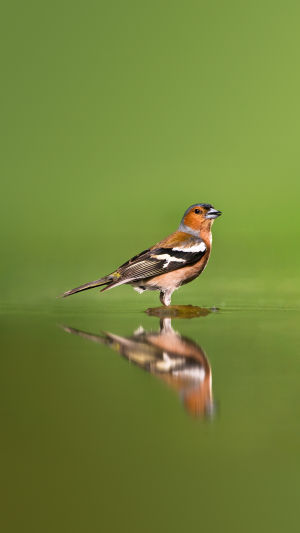Hello, Lykkers!Have you ever paused to listen to the cheerful song of a bird and wondered what it was trying to say? Today, let’s dive into the world of the chaffinch, a small yet fascinating songbird that has enchanted people for centuries with its melodies.
From its distinctive appearance to its unique singing habits, there’s so much to discover about this charming bird.
CHAFFINCH bird singing, beautifull bird sounds
video by Wildlife World
<h3>What Does a Chaffinch Look Like?</h3>
Chaffinches are small birds, measuring around 14–16 cm in length. Males are especially striking during the breeding season, with a blue-grey crown, reddish underparts, and distinctive white wing bars. Females, on the other hand, have a more muted greenish-brown tone, allowing them to blend seamlessly into their surroundings. No matter their color, all chaffinches share the same agile, lively movements that make them a delight to watch.
<h3>Where Do Chaffinches Live?</h3>
These birds have a wide range, spanning from Europe to North Africa and parts of Western Asia. Depending on the region, some chaffinches remain in one place year-round, while others migrate to avoid harsh winters. Their habitats include woodlands, parks, gardens, and even open fields, making them one of the most commonly spotted birds in many parts of the world.
<h3>The Art of Nest Building</h3>
Chaffinches are skilled architects when it comes to building their nests. They prefer tree branches as their construction sites, carefully weaving twigs and grass to create a secure structure. To make the nest less visible to predators, they cleverly use moss and lichen for camouflage. The female takes on the primary role of nest-building, ensuring a safe and cozy environment for her eggs.
<h3>Chaffinch Eggs and Parenting</h3>
Each breeding season, a female chaffinch lays about six eggs. These small eggs, often speckled with patterns, are carefully incubated until they hatch. During this period, the male plays an essential role by bringing food to the female, ensuring she has enough energy to care for the unhatched chicks. Once the young birds hatch, their diet consists mainly of insects, providing them with the necessary nutrients for growth.
<h3>The Chaffinch's Melodious Song</h3>
One of the most fascinating aspects of the chaffinch is its song. Males sing to attract mates and establish territory, with each bird capable of producing two to three different tunes. Interestingly, chaffinch songs vary by region—just like human dialects! Young chaffinches learn these songs from adult birds, but if they don’t hear them during their early development, they may never master the tune properly.
British ornithologist William Thorpe conducted research on this, discovering that young chaffinches raised without hearing adult songs could never fully develop their own melodies. He also found that male chaffinches rely on testosterone to sing properly—when deprived of this hormone, their singing ability weakens.
<h3>What Do Chaffinches Eat?</h3>
As chicks, chaffinches mainly consume insects, which are rich in protein and crucial for their growth. However, as they mature, their diet shifts primarily to seeds. This adaptability helps them survive throughout the year, even in colder months when insects are scarce.
<h3>Chaffinches in Winter: A Unique Migration Pattern</h3>
Unlike many bird species that migrate together, chaffinch migration is rather unusual. In Sweden, for example, female chaffinches often migrate alone in winter, leaving the males behind. This behavior is the reason behind their Latin name “Fringilla coelebs”, where “coelebs” means “bachelor.” While the females seek warmer climates, the males endure the cold, waiting for spring’s arrival.
<h3>A Bird That Occasionally Gets Lost</h3>
Though chaffinches are primarily found in Europe, North Africa, and Western Asia, there have been rare instances of these birds appearing in North America—most likely due to being blown off course during migration. While they don’t establish permanent populations there, these accidental visits make for an exciting sighting for bird enthusiasts.
<h3>Why Do We Love Chaffinches?</h3>
With their colorful feathers, cheerful songs, and fascinating behaviors, chaffinches are a true delight to observe. Whether they are singing their regional melodies, cleverly building nests, or embarking on their solo migrations, these little birds never fail to captivate us.
<h3>See You Next Time, Lykkers!</h3>
Next time you hear a bird’s song, take a moment to appreciate its melody—maybe it’s a chaffinch sending a message! Have you ever spotted one in the wild? Let’s share our birdwatching experiences and celebrate the wonders of nature together!





